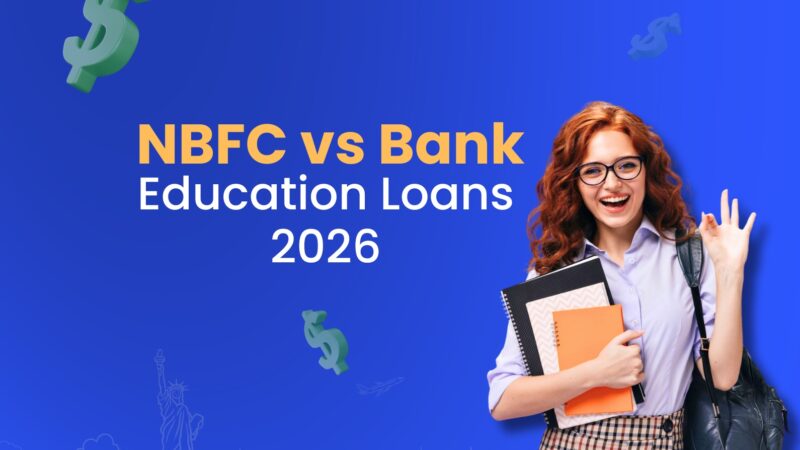
The Future of Study Abroad Financing: From Collateral Loans to AI‑Powered Approvals
In this article
- The Traditional Collateral Model: Strengths and Strains
- Case in India: SBI’s Collateral-Free Push
- Enter AI‑Powered Approvals: The New Frontier
- Comparative Snapshot: Collateral vs AI Models
- The Hybrid Model: Collateral + AI = Balanced Risk
- Real-World Challenges & Considerations
- Spotlights: SBI and Union Bank in the Current Landscape
- Union Bank of India: Collateral-Free Education Loans
- What This Means for Prospective Students
- Final Thoughts
- Frequently Asked Questions
Financing an overseas education has always been one of the steepest hurdles in the study abroad journey. In the traditional model, students and families heavily depended on banks to provide educational loans for abroad, often pledging property or other assets as collateral. But the tide is shifting.
A new era is emerging—one where study abroad education loan approvals are powered by data, algorithms, and AI systems that can assess risk in minutes rather than weeks. This blog explores that transition—from collateral-based lending to AI‑driven decisioning—and how it’s reshaping access, fairness, and speed in global education funding.
Find the Right Study Abroad Loan!
The Traditional Collateral Model: Strengths and Strains
In some countries, such as India, over the decades, banks providing educational loans for abroad, have been providing collateral-based education loans.
- The logic: less risk through collating the loan by physical security, i.e., immovable property, fixed deposits, or securities.
- There are several strengths of this model: reduced interest rates (because the bank’s risk is lessened). Well-defined responsibilities and backup in place when the default occurs.
- Easier to assess the creditworthiness of borrowers by banks.
However, there are also severe drawbacks to this system. Most bright students lack assets or guarantors, particularly underprivileged or rural students, which leaves them out of available global education opportunities.
The paperwork and valuation process for collateral often causes delays, and the threshold for collateral security frequently excludes smaller borrowers from contention.
Case in India: SBI’s Collateral-Free Push
Consider the State Bank of India (SBI), one of the largest lenders for overseas education in India. Under its Global Ed‑Vantage Scheme, SBI now offers collateral-free study abroad education loans up to ₹50 lakh for students going to eligible premier universities. Beyond that limit, collateral may still be required. This move is a clear signal that even traditional banking institutions are recognizing the limitations of the pure collateral model.
However, while SBI is pioneering this shift, many students still depend on standard collateralized loans or find their options constrained by university eligibility lists maintained by banks.
Enter AI‑Powered Approvals: The New Frontier
Artificial intelligence and machine learning (ML) are rapidly transforming financial services. In credit and lending, these technologies enable the analysis of non-traditional data, the detection of patterns, and the rapid making of credit decisions that humans alone cannot.
How AI & Automation are Redefining Ed Loan Decisions
- Data Integration & Alternative Signals: AI can consume academic history, past loan repayment history, bank statement habits, online footprints, etc to create an all-encompassing profile of the borrower.
- Predictive Modeling/Risk Scoring: ML models can be used to predict default probabilities based on large datasets and enhance the accuracy of credit scoring.
- Explainable AI (XAI): New techniques allow banks to understand why a given decision was made (e.g., SHAP values), helping satisfy regulatory and customer transparency requirements.
- Faster Turnaround: What would take weeks for human underwriters can be done in hours—or even minutes—by an AI framework.
- Adaptive Learning: As new data becomes available (repayments, performance patterns, macroeconomic variables), models evolve and refine their predictions.
In the study abroad domain, AI is already making inroads—not just in credit, but across the student lifecycle. Platforms are utilizing AI to match students with universities and scholarship options, as well as to assess language test probabilities.
For example, some newer startups leverage AI to estimate a student’s chances of securing an admissions offer or scholarship.
The Hybrid Model: Collateral + AI = Balanced Risk
It’s not going to be “all AI or nothing” overnight. The likely emerging paradigm is hybrid: combining collateral requirements with AI-driven decision support.
- For large loans (e.g. above ₹50 lakh in India), collateral may remain mandatory, but AI can optimize how much collateral is needed, or re-evaluate the existing collateral.
- For small to mid-size loans, AI scoring can assess candidates without collateral, making no-collateral or reduced-collateral options more viable.
- Collateral substitution: In some cases, digital assets or returns from a student’s future income projections may serve as “soft collateral.”
- Risk-based pricing: Instead of one-size-fits-all interest rates, AI can tailor interest rates to individual risk profiles—rewarding better candidates with lower rates.
This approach balances the security banks desire with the demands from students.
Comparative Snapshot: Collateral vs AI Models
| Dimension | Traditional Collateral Loans | AI‑Powered / Hybrid Model |
| Speed of approval | Weeks or months | Minutes to hours |
| Barrier to entry | High (requires assets or guarantors) | Lower (can work with nontraditional data) |
| Risk mitigation | Secured asset backing | Predictive models + collateral if needed |
| Transparency | Manual, rigid | With XAI, decisions can be explained |
| Scalability | Costly scaling of underwriters | Highly scalable via software |
| Custom pricing | Limited flexibility | Granular risk-based pricing |
Real-World Challenges & Considerations
- Data quality & bias: AI models are as good as the data they receive training on. Unfair decisions can be made using poor or biased datasets.
- Regulation/ compliance: The jurisdictions of many countries mandate that credit decisions should be audit-traced and understandable. The introduction of AI into loans should expect a regulatory examination.
- Adoption inertia in banking: Legacy systems, risk aversion, and conservative cultures can slow AI uptake.
- Hybrid complexity: Managing a system that blends human, AI, and collateral inputs is technically challenging.
- Fraud & security: New attack vectors emerge with AI systems—data poisoning, adversarial attacks, identity theft becomes more complex.
- Digital divide: Students without strong digital footprints or internet access may still be disadvantaged in AI systems.
Despite these obstacles, institutions that commit early to AI-based underwriting are at a competitive advantage in attracting the next generation of global learners.
Spotlights: SBI and Union Bank in the Current Landscape
SBI Abroad Education Loan (Global Ed‑Vantage and Vidya Lakshmi Schemes)
- SBI’s Global Ed‑Vantage supports overseas education in UK and beyond, offering loans from ₹7.5 lakh up to ₹3.0 crore in some cases.
- Crucially, SBI now provides collateral-free loans up to ₹50 lakh under certain conditions—this is a major shift from classic secured models.
- Interest rates for these education loans typically range from ~9.15% (secured) to ~9.65% or more (unsecured), depending on parameters.
- SBI maintains a list of approved foreign universities under its scheme; only students admitted to those institutions can leverage the no-collateral option.
Union Bank of India: Collateral-Free Education Loans
- Union Bank offers its Special Union Education Loan for Premier Institutes Abroad, with unsecured (no-collateral) loans up to ₹40 lakh for students accepted into universities on their approved list.
- For amounts above that threshold, collateral or security is required.
- Interest rates for secured and unsecured loans differ: for secured they may start around 9.25%, and for unsecured loans, starting rates could be ~9.75% (or higher, depending on risk and profile).
- The bank covers a broad set of study-abroad expenses: tuition, living costs, travel, books, and even laptop purchase.
These developments show that major public-sector banks are already experimenting with no-collateral components, but full AI-based underwriting is still in its early stages.
What This Means for Prospective Students
- Quicker Access to Funding — Students with strong digital records or academic credentials may soon get instant loan offers without needing property.
- Lower Barriers for Underprivileged Students — AI-based models could open doors for students who lack traditional collateral but have good merit and potential.
- Dynamic Interest Pricing — Rather than fixed bands, interest could be personalized based on a student’s complete profile.
- Increased Competition in Ed‑Finance — Fintechs and AI-native lenders may compete aggressively against traditional banks in the study abroad market.
- Adaptive Financial Advice — Platforms may recommend which institutions, loan options, or repayment plans suit individual profiles, powered by AI analysis.
However, students must stay alert:
- Be ready to share digital credentials and data (bank statements, academic transcripts, etc.)
- Maintain clean credit records or prior repayment history
- Understand the risk models—if you decline an AI-based loan offer, request a human review
- Stay informed about the algorithmic logic and any appeals or transparency mechanisms
Final Thoughts
The shift from pure collateral-based models to AI-powered financing represents a watershed moment in study abroad education loan systems. It carries the promise of inclusivity, speed, and fairness—but also demands responsible design, transparency, and regulation. Banking giants like SBI and Union Bank are taking steps, yet the future likely belongs to hybrid and full-AI lenders who can strike the right balance between risk, speed, and access.
If you’re preparing to study abroad, keep a close eye on platforms that offer AI-enabled loans or underwriting—because in the near future, you might secure a global education with just your profile, not your property.

Frequently Asked Questions
Can AI really replace collateral in student loans?
AI can’t entirely eliminate all risk, but it can reduce reliance on physical collateral by modeling creditworthiness via data. In hybrid models, collateral becomes optional or reduced for lower-risk borrowers.
Will traditional banks adopt AI lending?
Yes, but gradually. Many will adopt AI tools to assist underwriting, risk scoring, or monitoring—but still retain human oversight, especially for large or complex cases.
Are there education loans in India without collateral currently?
Yes. SBI’s Global Ed‑Vantage offers collateral-free loans up to ₹50 lakh under certain conditions. Union Bank also offers unsecured loans up to ₹40 lakh for approved institutions.
What data does AI use for credit scoring?
AI systems can ingest academic records, bank statements, digital transaction patterns, past loan behavior, demographic variables, and sometimes alternative data (mobile usage, utilities, etc.).
How can I increase chances of AI‑based loan approval?
Maintain clean financial records, strong academic profile, consistent banking history, minimal red flags in credit behavior, and engage with platforms that support new AI‑based underwriting models.
Book A Free Counseling
Related Blogs
Want to connect with
Our Experts?
We provide keep one to one counselling to
Study Abroad Aspirants









